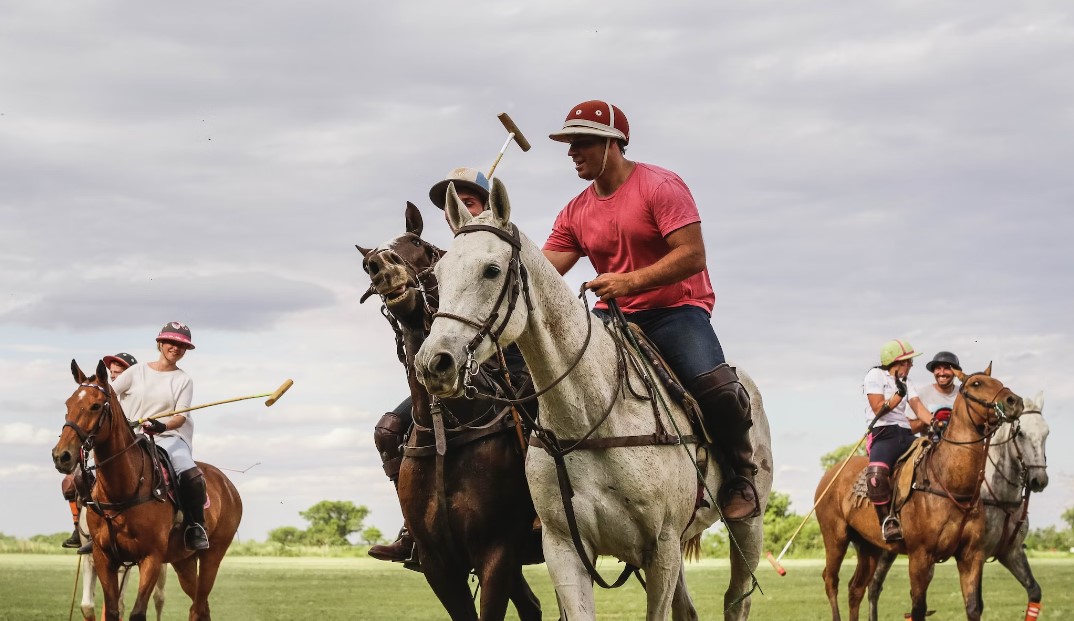Polo is known as the “sport of kings”, but its origins are much humbler. This article will explore the history of polo, from its beginnings over 2,500 years ago to its current status as an elite competitive sport played across the globe. We’ll examine how polo developed over centuries, spreading from East to West, and how the advent of formal rules and organisations in the 1800s transformed polo into the modern sport it is today.
Polo’s Ancient Origins and Early History
The earliest origins of polo lie in Central Asia, where nomadic tribesmen first played a primitive version of the game to hone their horseback riding skills. References to polo appear in the writings of 6th century Persian ruler Chosroes I and in the epic poem Shāhnāmeh. While early polo was a training exercise for cavalry units, the sport soon spread throughout the Persian empire. The Tang Dynasty brought polo to China in the 8th century. From there, the game disseminated to Japan in the 9th century where it became known as “the way of the ball”. For centuries, polo remained an aristocratic activity in East and Central Asia, popular among the ruling classes.
Polo first reached the western world in the 13th century as the Turkic Seljuk Empire expanded into Constantinople. British traders and diplomats returning from Persia introduced the sport to England. The game was embraced by English nobles and royalty. Queen Elizabeth I was an avid player. In the 19th century, British cavalry regiments stationed in India helped to popularise polo in the subcontinent. The first polo clubs emerged in India in the 1850s. Ever since, India has remained at the heart of the global polo scene.
Polo Comes to the Americas and Becomes Systematized
The conquest of the Americas led to polo’s diffusion across South and North America. Mexican settlers likely brought polo north, with the first clubs forming in the United States in the late 1800s. James Gordon Bennett, publisher of the New York Herald, later established the Westchester Cup in 1876, America’s first high-goal polo tournament. Meanwhile in Argentina, British ranch owners had established the River Plate Polo Association by the 1880s, giving rise to what is now the world’s strongest polo culture. Today, Argentina dominates professional polo.
Polo’s early history was defined by informally organised matches between aristocratic clubs. This changed in the late 1800s when retired British cavalry officer John Watson sought to make polo more systematic. Watson drafted the first modern rules in 1871, standardising the pitch, teams, equipment, and scoring. The Polo Association (later renamed Hurlingham Polo Association) was founded in 1890 to govern play in Britain. These developments facilitated matches between clubs from different regions. International competition began in 1886 when the US challenged England for the Westchester Cup. Standardised rules allowed polo clubs and match schedules to sprout worldwide by the early 1900s.
| Year | Key Development |
|---|---|
| 1876 | Establishment of the Westchester Cup, first high-goal polo tournament |
| 1871 | John Watson drafts first standardised polo rules |
| 1890 | Founding of the Polo Association in Britain |
| 1886 | First international polo match between US and England |
Polo as a Global Sport in the 20th Century
In the 20th century, polo grew beyond its aristocratic origins to become a global sport. The establishment of national governing bodies and international tournaments accelerated this trend.
Argentina’s wealth of polo talent has made it the sport’s modern powerhouse. Following WWII, 10-goal Argentinian player Adolfo Cambiaso Sr. dominated international play. More recently, Adolfo Cambiaso Jr. has defined the sport, competing on elite circuits across Argentina, the US, and Europe.
International competition has also expanded significantly. The first international women’s test matches occurred in the 1930s between British and American players. Argentina, Chile, England, Australia, New Zealand and South Africa compete biennially in the Coronation Cup, instituted in 1953. Polo has even reached the Olympic stage on a few occasions as a demonstration sport, appearing in 1900, 1908, 1920, 1924 and 1936.
Today, over 100 countries field national teams. Polo continues to expand globally thanks to its growing popularity across Asia. China has emerged as polo’s new frontier, with an exponential increase in polo clubs over the past decade.
The Modern Sport of Polo
Polo has come a long way from its nomadic origins thousands of years ago. While previously dominated by the European and Argentinian aristocracy, today polo is growing more democratic internationally. Amateur clubs allow new generations of players to take up the “sport of kings”.
Polo is now played professionally in nearly 60 countries. The sport follows strict rules codified by national and international governing bodies. High-goal tournaments, such as Argentina’s Argentine Open, draw the world’s best players to compete for multimillion dollar purses. Top professionals, like 10-goal player Adolfo Cambiaso Jr., are global superstars.
Corporate sponsorship and TV broadcasting are modern innovations that have increased polo’s exposure. Polo’s global footprint continues to expand, especially across emerging hotspots like China. While its elite heritage remains, polo is now becoming accessible to more participants internationally. Polo has been transformed from an informal pastime of Persian antiquity to a modern global sporting spectacle.
In summary, polo has undergone a remarkable evolution over thousands of years. From its origins as a training exercise for Asian nomads, it has become a sophisticated global sport played on every continent. Key milestones included the codification of rules in the 19th century and the innovation of high-goal tournament play. While polo was once restricted to aristocrats, today it is growing more inclusive. Polo’s ongoing globalisation points to an exciting future defined by greater participation and competition worldwide. Above all, polo’s centuries-old history shows that a pastime that was once confined to antiquity can transform into a thriving modern sport through persistent human innovation.

Leave a Reply